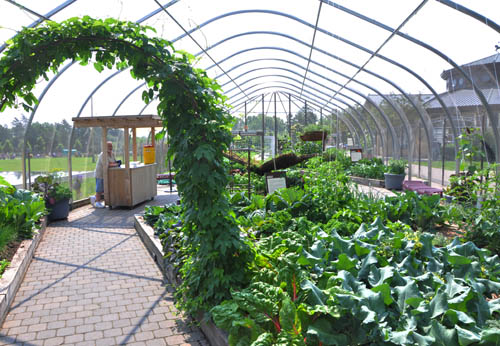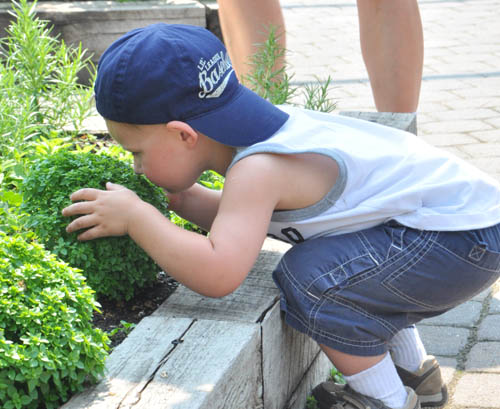Something delicious is popping up in Como Zoo and Conservatory’s gardens. The Chipotle Edible Garden allows visitors to see how edible gardens can both influence landscape design and provide an abundance of produce throughout the season.
“It’s a good way to show homeowners how to grow vegetables without having the traditional row garden,” said Angie Senn, Edible Garden manager, as she pointed to a trellis of hops arching over a walkway.
 The 8,000-square-foot exhibit, housed in the former butterfly garden enclosure, features beds filled with vegetables, fruits and herbs. This doesn’t look like your run-of-the-mill garden, though; curved lines and decorative trellises help it appear more ornamental, said Senn.
The 8,000-square-foot exhibit, housed in the former butterfly garden enclosure, features beds filled with vegetables, fruits and herbs. This doesn’t look like your run-of-the-mill garden, though; curved lines and decorative trellises help it appear more ornamental, said Senn.
“We grow a lot of different stuff that maybe your typical homeowner might not grow,” said Senn. “But all of this stuff can be grown within a typical Minnesota garden.”
Beauty and the beets
Beds of leafy kale and collards are accented by bright purple brussel sprout plants and orange rhubarb stalks. Tomatoes snake their way up a wire suspended from the ceiling. By the end of the season, the plants will reach all the way to the top and produce tomatoes along the entire reach. A large herb garden, lush with mint, basil, and rosemary, dominates the middle of the garden.
The garden provides free daily classes at 12 p.m. and 3 p.m. that cover everything from worm composting to salsa making. More about Como Zoo's Chipotle Edible Garden events and classes.
Along with providing an educational experience for visitors, the harvested produce is used to supplement the diets of several animals at the zoo.
“We have a lot of collards and kale; many of the animals eat those,” said Senn.
Surplus produce sent to city recreational centers
Animals aren’t the only ones that the garden feeds. Produce that can’t be used by the zoo is sent to St. Paul Recreation Centers around the city to be used in their free summer meal and cooking programs. Some of the produce is used to make healthy snacks and help educate children in the city’s “Summer Blast” program about where their food comes from.
 “Our first year we sent everything to the animals, but it kind of became too much, so last year we sought out the recreation centers,” said Senn. “When we found out that they had an awesome cooking class, we sent all the produce to them.”
“Our first year we sent everything to the animals, but it kind of became too much, so last year we sought out the recreation centers,” said Senn. “When we found out that they had an awesome cooking class, we sent all the produce to them.”
Last year the garden produced just over 2,000 pounds of produce. About one quarter of that went to feeding zoo animals with the rest, almost 1,500 pounds, going to the recreation centers, Senn said.
“The kids get a real kick out of it that the animals get the first choice of food,” said Linda Flynn, programming supervisor for the City of St Paul. “It’s a learning activity for them; they think it’s so much fun.”
The restaurant chain Chipotle stepped into help fund the garden this year, donating $10,000. Chipotle is known for using organically grown produce and antibiotic-free meats, Senn said.